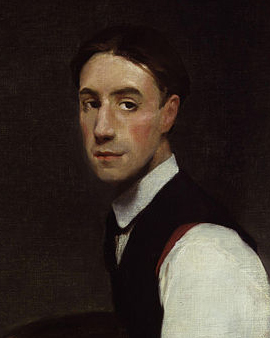It was a long time before the London-born painter and sculptor Glyn Warren Philpot was rediscovered for the art world. The English painter Philpot is particularly well known for his models, which were rare and exotic in those days: his favourite model was his West Indian servant Henry Thomas. After his paintings were ignored for many years after his death, a new interest in Philpot's work arose in the 1970s. His revived reputation is attributed to his enthusiasm for the Art Deco style. Many critics claim Philpot to be a representative of the Art Deco style.
The talented Philpot was a student at the Lambeth School of Art in England and at the Académie Julian in Paris. Philpot had his greatest success as a portraitist. His works of the 1920s are regarded as his artistic peak. In addition to his portraits, his historical murals for St. Stephen's Hall in Westminster are particularly well known. The English painter converted to Catholicism in 1905 and became enthusiastic about depicting allegories and religious motifs. Philpot made a good living from his fashionable portrait paintings, which he routinely made for wealthy patrons. No matter how lucrative it was for the ambitious painter, he always tired of the same and hardly creative scheme. In 1931 Philpot therefore moved to Paris for a year. Here he could work on his personal painting style. In contrast to his commissioned paintings, this style was flatter and more stylized. The new style not only met with a good response. Philport's avant-garde desire to express himself and his sexuality in his works was not appreciated by many former admirers of his earlier works. They were even horrified and reacted mockingly, as evidenced by a headline in a magazine of the time: "Glyn Philpot goes Picasso" (Philpot makes you Picasso).
The Edwardian era in which Philpot lived brought new opportunities and rights for women and workers. However, society was still very strict and even a suspicion of homosexuality was tantamount to social decline. However, homosexual artists of that time, such as writer Oscar Wilde and illustrator Aubrey Beardsley, left important traces and were without doubt early role models for Philpot. The immense tension between his life as a public figure and his private life is evident in his work. The strictly academic religious works and portraits of the elite paid his bills and allowed him to experiment with more sexual subjects and studies of the male nude far from the mainstream. Painting and presenting a male nude for the art world was a defiant step that required a lot of courage.
Philpot died suddenly of heart failure in his London studio. Badly affected by his premature death, his friend and student Vivian Forbes committed suicide with an overdose of sleeping pills. Philport temporarily shared a house and a studio with the charming but unstable Forbes at Lansdowne House in London. Forbes' growing obsession with Philpot caused problems for both. However, the turbulent relationship was also a source of inspiration for both men.
×





_-_(MeisterDrucke-1398535).jpg)
_-_(MeisterDrucke-1398535).jpg)
_-_(MeisterDrucke-204476).jpg)
_-_(MeisterDrucke-204476).jpg)
.jpg)
.jpg)
.jpg)
.jpg)
.jpg)
.jpg)
_-_(MeisterDrucke-901347).jpg)
_-_(MeisterDrucke-901347).jpg)
.jpg)
.jpg)
_-_(MeisterDrucke-1316076).jpg)
_-_(MeisterDrucke-1316076).jpg)
.jpg)
.jpg)
.jpg)
.jpg)
_-_(MeisterDrucke-569440).jpg)
_-_(MeisterDrucke-569440).jpg)
.jpg)
.jpg)
.jpg)
.jpg)
.jpg)
.jpg)
_-_(MeisterDrucke-1120579).jpg)
_-_(MeisterDrucke-1120579).jpg)
.jpg)
.jpg)
.jpg)
.jpg)
.jpg)
.jpg)
.jpg)
.jpg)
.jpg)
.jpg)
.jpg)
.jpg)
_-_(MeisterDrucke-1132785).jpg)
_-_(MeisterDrucke-1132785).jpg)
.jpg)
.jpg)
_-_(MeisterDrucke-1115700).jpg)
_-_(MeisterDrucke-1115700).jpg)
_-_(MeisterDrucke-1515384).jpg)
_-_(MeisterDrucke-1515384).jpg)
.jpg)
.jpg)
.jpg)
.jpg)
.jpg)
.jpg)
.jpg)
.jpg)
.jpg)
.jpg)
.jpg)
.jpg)
.jpg)
.jpg)
.jpg)
.jpg)
.jpg)
.jpg)
.jpg)
.jpg)
.jpg)
.jpg)
.jpg)
.jpg)
_-_(MeisterDrucke-904678).jpg)
_-_(MeisterDrucke-904678).jpg)
.jpg)
.jpg)
.jpg)
.jpg)
.jpg)
.jpg)
 1917 - (MeisterDrucke-297926).jpg)
 1917 - (MeisterDrucke-297926).jpg)
.jpg)
.jpg)
.jpg)
.jpg)
_-_(MeisterDrucke-891431).jpg)
_-_(MeisterDrucke-891431).jpg)
_-_(MeisterDrucke-1316095).jpg)
_-_(MeisterDrucke-1316095).jpg)
_-_(MeisterDrucke-1316134).jpg)
_-_(MeisterDrucke-1316134).jpg)
.jpg)
.jpg)
.jpg)
.jpg)
.jpg)
.jpg)
.jpg)
.jpg)
_-_(MeisterDrucke-1316055).jpg)
_-_(MeisterDrucke-1316055).jpg)
.jpg)
.jpg)
_-_(MeisterDrucke-890215).jpg)
_-_(MeisterDrucke-890215).jpg)
.jpg)
.jpg)
_-_(MeisterDrucke-1316113).jpg)
_-_(MeisterDrucke-1316113).jpg)
.jpg)
.jpg)
.jpg)
.jpg)
.jpg)
.jpg)
.jpg)
.jpg)
.jpg)
.jpg)
.jpg)
.jpg)
.jpg)
.jpg)
.jpg)
.jpg)
.jpg)
.jpg)
_-_(MeisterDrucke-569436).jpg)
_-_(MeisterDrucke-569436).jpg)
.jpg)
.jpg)
.jpg)
.jpg)
.jpg)
.jpg)
.jpg)
.jpg)
_-_(MeisterDrucke-1122162).jpg)
_-_(MeisterDrucke-1122162).jpg)
.jpg)
.jpg)
.jpg)
.jpg)
.jpg)
.jpg)
_-_(MeisterDrucke-1316115).jpg)
_-_(MeisterDrucke-1316115).jpg)
.jpg)
.jpg)
_-_(MeisterDrucke-1420109).jpg)
_-_(MeisterDrucke-1420109).jpg)
.jpg)
.jpg)
.jpg)
.jpg)
.jpg)
.jpg)
.jpg)
.jpg)
_-_(MeisterDrucke-318937).jpg)
_-_(MeisterDrucke-318937).jpg)
_(detail_of_187950)_-_(MeisterDrucke-935193).jpg)
_(detail_of_187950)_-_(MeisterDrucke-935193).jpg)
.jpg)
.jpg)
.jpg)
.jpg)
.jpg)
.jpg)
.jpg)
.jpg)
.jpg)
.jpg)
.jpg)
.jpg)
_-_(MeisterDrucke-1132786).jpg)
_-_(MeisterDrucke-1132786).jpg)
.jpg)
.jpg)
.jpg)
.jpg)
.jpg)
.jpg)
_-_(MeisterDrucke-1316110).jpg)
_-_(MeisterDrucke-1316110).jpg)
_-_(MeisterDrucke-269933).jpg)
_-_(MeisterDrucke-269933).jpg)
.jpg)
.jpg)
 - (MeisterDrucke-244363).jpg)
 - (MeisterDrucke-244363).jpg)
.jpg)
.jpg)
.jpg)
.jpg)
.jpg)
.jpg)






